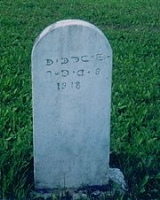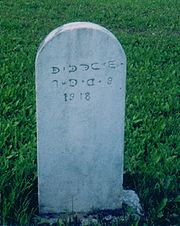
Carrier syllabics
Encyclopedia

Adrien-Gabriel Morice
Adrien-Gabriel Morice was a missionary priest belonging to the Oblates of Mary Immaculate. He served as a missionary in Canada, and created a writing system for the Carrier language.-Early life:...
for the Carrier language
Carrier language
The Carrier language is a Northern Athabaskan language. It is named after the Dakelh people, a First Nations people of the Central Interior of British Columbia, Canada, for whom Carrier is the usual English name. People who are referred to as Carrier speak two related languages. One,...
. It was inspired by Cree syllabics
Cree syllabics
Cree syllabics, found in two primary variants, are the versions of Canadian Aboriginal syllabics used to write Cree dialects, including the original syllabics system created for Cree and Ojibwe. Syllabics were later adapted to several other languages...
and is one of the writing systems in the Canadian Aboriginal syllabics
Canadian Aboriginal Syllabics
Canadian Aboriginal syllabic writing, or simply syllabics, is a family of abugidas used to write a number of Aboriginal Canadian languages of the Algonquian, Inuit, and Athabaskan language families....
Unicode range.
History
The Dakelh people once enjoyed extensive literacy with the script. It is recorded that it was often used to write messages on trees, and Morice published a newspaper in syllabics which was in print from 1891 to 1894. Some transcriptions of Latin and English have been recorded as well. Its usage began to decline around 1920, when the Carrier language was banned from the local schools. In liturgical publications, such as prayer books, the Carrier language became written in a non-standard form of the Latin alphabetLatin alphabet
The Latin alphabet, also called the Roman alphabet, is the most recognized alphabet used in the world today. It evolved from a western variety of the Greek alphabet called the Cumaean alphabet, which was adopted and modified by the Etruscans who ruled early Rome...
, which used many English sound values, such as ⟨oo⟩ for /u/ and ⟨u⟩ for /ʌ/. The switch was rather abrupt, to the point that parents would write in syllabics and their children would write in the alphabet, and neither could understand the other's writing.
In the 1960s, the Carrier Linguistic Committee in Fort St. James
Fort St. James, British Columbia
Fort St. James is a district municipality and former fur trading post in north-central British Columbia, Canada. It is located on the south-eastern shore of Stuart Lake in the Omineca Country, at the northern terminus of Highway 27, which connects to Highway 16 at Vanderhoof...
created a standardized form of the Latin alphabet for usage in the Carrier language. This is now the preferred form of writing the language, although Carrier syllabics is still often seen as more authentic to the culture.
Description
Carrier syllabics is designed so that syllables which begin with the same consonant have the same basic form. Depending on the following vowel, this form may be rotated, flipped, or a diacriticDiacritic
A diacritic is a glyph added to a letter, or basic glyph. The term derives from the Greek διακριτικός . Diacritic is both an adjective and a noun, whereas diacritical is only an adjective. Some diacritical marks, such as the acute and grave are often called accents...
may be added in the center. There are special characters for consonants at the end of a syllable
Syllable coda
In phonology, a syllable coda comprises the consonant sounds of a syllable that follow the nucleus, which is usually a vowel. The combination of a nucleus and a coda is called a rime. Some syllables consist only of a nucleus with no coda...
.
Carrier syllabics is written from left to right. Morice originally intended to have regular spacing between words; however, in practice the letters were sporadically spaced, and the gaps between them did not often correlate to separate words. There was no formally defined punctuation
Punctuation
Punctuation marks are symbols that indicate the structure and organization of written language, as well as intonation and pauses to be observed when reading aloud.In written English, punctuation is vital to disambiguate the meaning of sentences...
; Morice used the modern punctuation of the Latin alphabet.
| u | o | ə | e | i | a | no vowel | |
|---|---|---|---|---|---|---|---|
| ʔ | ᐁ | ᐃ | ᐅ | ᐈ | ᐉ | ᐊ | |
| m | ᘈ | ᘉ | ᘊ | ᘋ | ᘌ | ᘍ | ᑦ |
| n | ᘂ | ᘃ | ᘄ | ᘅ | ᘆ | ᘇ | ᐣ |
| p (b) | ᗨ | ᗩ | ᗪ | ᗫ | ᗬ | ᗭ | ᗮ |
| t (d) | ᑌ | ᑎ | ᑐ | ᑓ | ᑔ | ᑕ | ᐪ |
| tʰ (th) | ᗜ | ᗝ | ᗞ | ᗟ | ᗠ | ᗡ | |
| tʼ (tt) | ᗢ | ᗣ | ᗤ | ᗥ | ᗦ | ᗧ | |
| ts (dz) | ᙈ | ᙉ | ᙊ | ᙋ | ᙌ | ᙍ | |
| tsʰ (ts) | ᙡ | ᙢ | ᙣ | ᙤ | ᙥ | ᙦ | |
| tsʼ (tts) | ᙧ | ᙨ | ᙩ | ᙪ | ᙫ | ᙬ | |
| s | ᙎ | ᙏ | ᙐ | ᙑ | ᙒ | ᙓ | ᔆ |
| z | ᙀ | ᙁ | ᙂ | ᙃ | ᙄ | ᙅ | ᙆ |
| tɬ (dl) | ᘨ | ᘩ | ᘪ | ᘫ | ᘬ | ᘭ | |
| tɬʰ (tlh) | ᘴ | ᘵ | ᘶ | ᘷ | ᘸ | ᘹ | |
| tɬʼ (tl) | ᘺ | ᘻ | ᘼ | ᘽ | ᘾ | ᘿ | |
| ɬ (lh) | ᘮ | ᘯ | ᘰ | ᘱ | ᘲ | ᘳ | ᒡ |
| l | ᘢ | ᘣ | ᘤ | ᘥ | ᘦ | ᘧ | ᑊ |
| tʃ (j) | ᘔ | ᘖ | ᘗ | ᘘ | ᘙ | ᘛ | |
| tʃʰ (ch) | ᙛ | ᙜ | ᙝ | ᙞ | ᙟ | ᙠ | |
| tʃʼ (jj) | ᘜ | ᘝ | ᘞ | ᘟ | ᘠ | ᘡ | |
| ʃ (sh) | ᙔ | ᙕ | ᙖ | ᙗ | ᙘ | ᙙ | ᙚ |
| j (y) | ᘎ | ᘏ | ᘐ | ᘑ | ᘒ | ᘓ | |
| k (g) | ᗯ | ᗰ | ᗱ | ᗲ | ᗳ | ᗴ | ᐟ |
| kʰ (kh) | ᗵ | ᗶ | ᗷ | ᗸ | ᗹ | ᗺ | ᐠ |
| kʼ (kk) | ᗻ | ᗼ | ᗽ | ᗾ | ᗿ | ᘀ | ᘁ |
| x (gh) | ᗄ | ᗅ | ᗆ | ᗇ | ᗈ | ᗉ | ᐥ |
| ɣ (r) | ᗊ | ᗋ | ᗌ | ᗍ | ᗎ | ᗏ | ᐦ |
| hw | ᗖ | ᗗ | ᗘ | ᗙ | ᗚ | ᗛ | |
| w | ᗐ | ᗑ | ᗒ | ᗓ | ᗔ | ᗕ | |
| h | ᐯ | ᐱ | ᐳ | ᐶ | ᐷ | ᐸ | ᑋ |
Suffix ⟨ᐤ⟩ or ⟨ᐧ⟩ indicates long vowels. There is a final ⟨ᓑ⟩ for /ŋ/, and an initial ⟨ᙇ⟩ for French j. There are no dedicated series for /kʷ kʷʰ kʷʼ xʷ ɣʷ/; presumably the vowelless variants of /k kʰ kʼ x ɣ/ are combined with the /w/ series, since only /k/ occurs finally. A variant of ᔆ is used for the laminal/apical distinction, but it is not supported by Unicode and in any case the rest of the series is missing.
Prefix ⟨ᕯ⟩ marks proper names.
Unicode has interchanged the /tsʰ/ and /tʃʰ/ series compared to Morice (1890): they have /tsʰ/ (ch) and /tʃʰ/ (ts) rather than /tsʰ/ (ts) and /tʃʰ/ (ch) . Some fonts have ᘨ /tɬu/ dlu reversed: the serif
Serif
In typography, serifs are semi-structural details on the ends of some of the strokes that make up letters and symbols. A typeface with serifs is called a serif typeface . A typeface without serifs is called sans serif or sans-serif, from the French sans, meaning “without”...
should be on the left, as in lu, not the right as in tlu.

